#Viceroyalty of New Spain
Photo

El entierro de Cristo
by Baltasar de Echave y Rioja (Novohispanic, 1632 - 1682)
oil on canvas (254,5 × 279 cm), 1665
Museo Nacional de Arte, Ciudad de México
#713966141361586176/IKpznwBI#Baltasar de Echave y Rioja#Catholic Church#Monarquía Hispánica#Spanish Empire#Viceroyalty of New Spain#17th century#1665#Baroque#México#oil on canvas#sacred art#paintings
69 notes
·
View notes
Text
Thus there are only two Black Mexicans who will be noted in the shortest day in terms of numbers of posts and topics:
As such there are but two individuals to single out in Mexican history. One is Gaspar Yanga, the architect of the first great slave rebellion in the North American continent by a maroon community. His rebellion was also the first great challenge New Spain faced and in a sense pointed to the future and Father Hidalgo's movement.....and the shadows of the difficulty of New Spain/Mexico in holding onto territory in reality as well as on paper.
Yanga was and is also an illustration of a reality in the limitations of Latin American history in neglecting the long colonial era. The Audiencias and Viceroyalties had a history that very much shaped the path that the post-independence states followed.
#lightdancer comments on history#black history month#afro-mexican history#gaspar yanga#viceroyalty of new spain
4 notes
·
View notes
Photo

The Spanish Empire in 1600.
« Atlante storico », Geo-Mondadori, 2000
via cartesdhistoire
The Spanish West Indian Empire was centered in the north on the Viceroyalty of New Spain and in the south on the Viceroyalty of Peru. It was enriched with the Philippine Islands from 1565, after the Spaniards discovered routes enabling them to cross the Pacific Ocean. In 1571, the city of Manila was founded there.
From 1546, the Spanish exploited the mines of Potosi (Upper Peru), from which most of the world's silver was quickly extracted. From 1564, a convoy system of galleons loaded with silver crossed the Atlantic Ocean to reach Spain. In the Pacific, once a year, the Manila Galleon transported silver from the New Spanish port of Acapulco to Manila in the Philippines. It made the return trip from the Philippines to Acapulco, carrying silk, porcelain, and Chinese lacquerware. From the 1590s, the value of this silver crossing the Pacific Ocean equaled all Atlantic trade combined.
74 notes
·
View notes
Text

I find Olrox to be a interesting character because he always speaks in double meaning which everything can be put into interpretation. For example: first episode; “Don’t listen to her Richter there is always a choice.”
Kinda found it strange why Olrox spoke to Richter first and even at all! Why communicate with the kid if he was solely there to kill Julia? Than it’s followed up years later where Richter pulls the same question on Olrox too. Perhaps he gave Julia a choice between sparing his lover’s life or he’ll hunt her down and kill her. Or if he hurt her son which is unlikely because I don’t see Olrox hurting kids.
Another example with Olrox seeking Mizrak out in the courtyard when he straddles Mizrak and playfully says: “let’s do this again, somewhere more comfortable”
That did itch my brain a little and I assume it was just queer baiting or a funny innuendo for the fan service or that Olrox wishes to discuss some where comfortable that is environmentally friendly because he is a vampire and they were out in the sun. Next scene they were in bed and oh— OH! congratulations on the show writers for not pulling back any punches! In the inn scene it’s far more insightful when Olrox drops in that “there are demons that were gods and some that still are” which Mizrak throws a hissy fit that there is ONE God. He doesn’t humor Olrox on that any further and stalks off. Olrox walks into the window watching him leaving while standing around direct sunlight and scoffs at Mizrak’s “one god” as if there is only ONE and that his only one god can protect him. Which brings to mind that Olrox being the avatar of Quetzalcoatl is far stronger and completely on the nose. As if saying Mizrak’s only one god will not protect him and it’s Olrox that protected Mizrak in the big fight in the end.
In the alley Drolta finds Olrox eating his Happy Meal and asks if he likes “striking terror in the hearts of children.” Which Olrox assumes the scrappy boy that ran off and he prefers to eat zesty blue bloods from the nobles. Drolta clarifies she meant Richter which he responds to “oh, him.” Richter was not in his mind at all. Richter didn’t have make much of an impact compared to how Olrox had on Richter. He calls Richter “SON of an old foe.” He doesn’t see Richter as a foe or enemy. He sort of smiles and is blasé about it. Julia was his enemy who killed his lover and his revenge died with her. Richter was simply collateral damage and not his enemy. So he doesn’t have any ill will towards Richter.
Another with Drolta and Olrox having a mid night stroll in the cemetary when she talks about creating a new world. Those can be two different things. One of them can be and OBVIOUSLY the fall of the Aztec empire where conquistadors wanted to convert the Aztec empire to Christianity and Catholic. Reading back in history the Aztec Empire became New Spain and the rest of South America like Colombia, Ecuador, and Venezuela were combined into a really powerful empire from New Spain or Viceroyalty of New Spain to The New Grenada and later The Grand Colombia. But that’s like years later.
His interactions with her are my favorite when he looks up at the sky and knows when the sun is coming up. Nor does he clarify when Drolta says vampires feel it because it’s dread. Olrox looks unbothered and asks her if she should be inside and concerned for her safety. Olrox si like Alucard and can be in the sun because of being the avatar of Quetzalcoatl. She asks flirtatiously where Olrox is staying while Olrox answers reciprocates the flirtation and says he likes “to keep his ear on the ground.” As if answering he likes to be a fly on the wall and to go unnoticed while watching everyone else tear down each other’s throats.
The most obvious part we see Olrox a little distress and and looking a bit vulnerable when he’s in the presence of Erzsebet. Olrox tends to butter people up with his interactions with playful banter but he doesn’t even hide his disgust on Erzsebet and doesn’t even let Drolta finish her introduction. His eye twitches whenever Erzsebet he refers to “dragon.”
Olrox is not a dragon but a serpent and dragons are a European creatures so referring Olrox a dragon is not only offensive but erasing his heritage and culture and who he is. Olrox is the avatar of Quetzalcoatl AKA the Feathered Serpent and it’s literally on the nose. Olrox gave a teeny tiny half ass bow when Drolta told him to and gave a full bow when Erzsebet showed off her glowy ball. The sheer disgust on his face not only tells me he had done this before. A lot of times from many conquerers he had to swallow his pride and bow. Anger, humiliation and that scathing look tells it all. He was forced to help these conquistadors to colonize his empire and slaughter his people and he’s reliving it again.
Another can of worms where Olrox pulls a Zuko officially joining on their side to take down Erzsebet. He has an ulterior motive and doesn’t want the world to be in eternal darkness. Olrox isn’t here to fight Richter at all and has nothing against him so their animosity is one sided. Olrox keeps a safe distance but not for himself but also Richter so he won’t get spooked. There is no audience to show off his influence like he had in cellar he was basically flirting or fucking with him. Calling Richter “Little Boy Belmont,” to unnerve him establish dominance and control of the situation so this fight won’t continue any further and mostly to protect Mizrak because Richter and Mizrak were about to brawl. Olrox was putting on a big show to showcase his powers and influence for the Abbot and Drolta to witness. Olrox has a reputation all the way across the ocean so he wanted to make a good impression and all he had to do was stand there and he made Richter Scooby Doo Run out of the cellar. The fight was neutralized and went on his merry way.
Olrox isn’t here to hurt Richter both physically or psychologically like that stunt in the cellar. It’s just them now in the woods. When Olrox says “I could’ve killed you three times by now, ironic I think for the both of us I need a Belmont.” I think there is more history between them that we did not see. Maybe it was with his mother and Olrox and Julia were friends or allies way back when. Olrox treated her with respect and calling her by her full name before the fight and was only here to kill Julia. He says he needs a Belmont but WHICH Belmont? It could be any Belmont! Julia was his go-to person before he killed her and Juste was in France and Richter was a child. Now he’s grown up and a fully realized hunter he’s capable of helping Olrox. I really don’t know what Olrox meant killing Richter “three times.” Maybe as a child, or in the cellar or now during the fight in the woods. There is an unspoken debt between Olrox and the Belmonts and during his long life he knew the Belmonts really well and had contact with them in some way.
Olrox is so mysterious of what he says or does and it isn’t subtle because there is always double meaning behind his words.
45 notes
·
View notes
Text
Reales, pieces of eight, doubloones and ducats
Who doesn't know it, in films and books there are always stories about great pirate treasures and lots of coins are shown. But what kind of coins are they? Here is a small overview.
Silver real
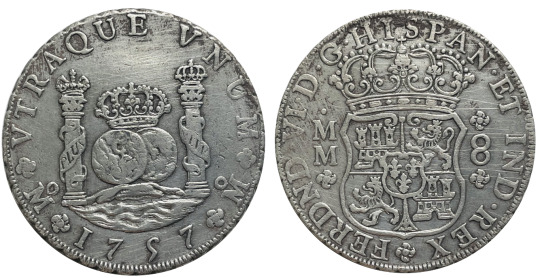
Silver coin: 8 reales Fernando VI, Viceroyalty of New Spain - 1757 (x)
The real was a coin and a currency in Spain for several centuries after the mid-14th century, weighing 0,12 ounces (3,43g) of silver, and these were eight reales to a peso, hence the term " pieces of eight" for pesos.
Silver piece of eight or Spanish Dollar

Spanish piece of eight, 1780 (x)
Was an early Spanish silver dollar sized coin, with a content of 25.563 g = 0.822 oz t fine silver. As Spanish mints issued silver denominations smaller than eight reales relatively infrequently, these coins would sometimes be chopped up into smaller pieces to provide small change. In the 17th and 18th centuries, so many were in circulation that they were accepted almost anywhere in the world. The American doller sign $ was derived from the figure 8 stamped on the side of the piece of eight, the silver peso (or piaster). They were minted at Mexico City and Lima in Peru, and were common currency in all of England's colonies, being valued at four shillings and sixpence. Often they wre cut into eight pieces for ease of transaction, so that two bits made a quarter. The origin of the American phrase, not worth two bits, is from the days when the English colonies around Massachusetts used this Spanish money. Pieces of eight were produced for about 300 years, in Mexcio, Peru and Colombia, and they became the standard unit of trade between Europe and China. They wre legal tender in the USA until 1857. Before the Spanish started exploiting Potosi in Peru (in today's Bolivia), silver was almost as valuable as gold in the Old World. Such were the quantities taken from the New World, that silver dropped to about a 1/5 of the value of gold. The Spanish exported four billion pesos of silver and gold from the New World between 1492 and 1830.
Gold ducat
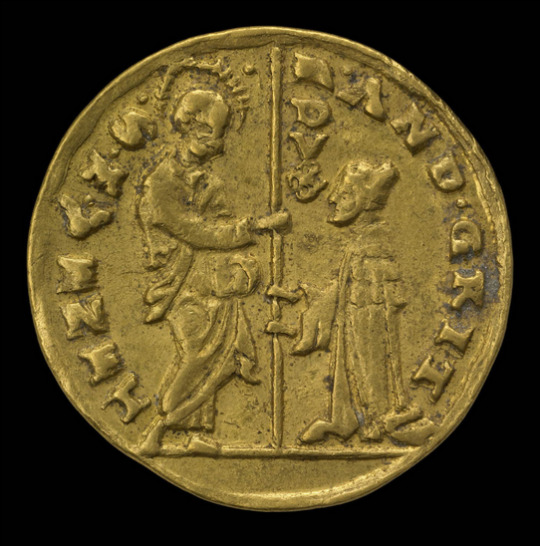
Gold ducat of Venice. Doge Andrea Gritti, Italy, 1523-38 (x)
This was the European gold trade coin, containing around 3.5 grams (0.11 troy ounces) of 98.6% fine gold, during the late medieval and early modern period. The name derives from ducatus, the Latin form of the title of the Doge of Venice, whre the ducat was first issued 1284. Called the ducado, it was worth less than a doubloon, about 10-11 silver reales, and was known to the British seaman as a ducat. The coin was copied throughout mainland Europe, and coins of the ducat standard were struck in several European countries up to the 20th century.
Gold doubloon (doblôn)

Spanish 4-doubloon, or doubloon of 8 escudos, stamped as minted in Mexico city mint in 1798 (x)
This was an early Spanish gold coin, worth approximately $4 (four Spanish dollars) or 32 reales, and weighing 6.766 grams (0.218 troy ounce) of 22-karat gold (or 0.917 fine; hence 6.2 g fine gold). The name originally applying to the gold excelente of Ferdinand and Isabella. It was later transferred to the two escudo coin issued by Spain and the Spanish colonies in the Americas. It was the largest Spanish gold coin, weighing slightly less than an ounce of gold, and originates from the Latin word duplus, or double. A doubloon was worth about seven weeks wages to a sailor.
#naval history#general history#coins#reales#piece of eight#doubloon#ducat#medieval seafaring#age of discovery#age of sail#age of steam
208 notes
·
View notes
Text


Old times of the Viceroyalty of New Spain.
references
29 notes
·
View notes
Photo
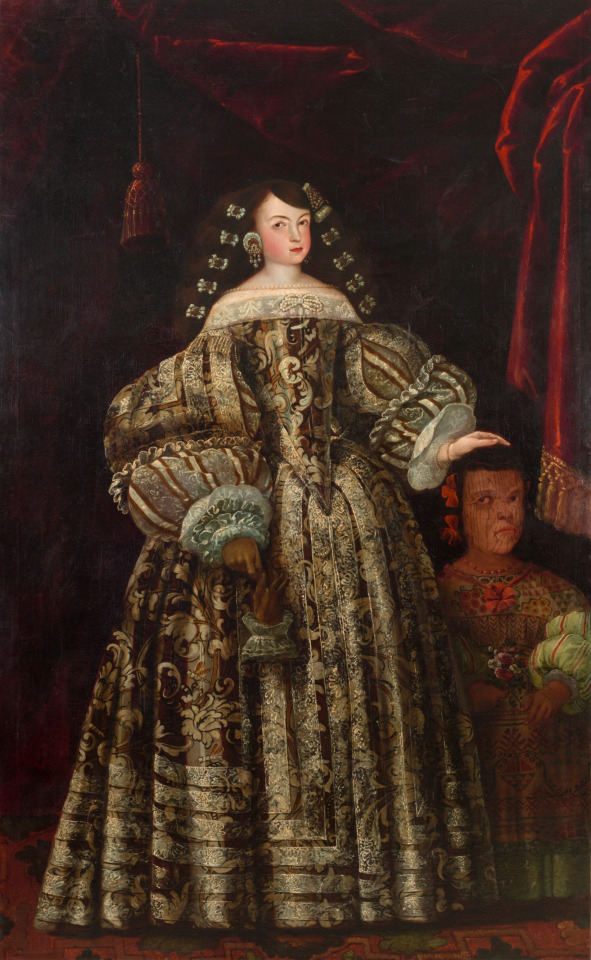
Antonio Rodríguez Beltrán, attributed (Spanish, 1636-1691)
María Luisa de Toledo e indígena, 1670
Museo Nacional del Prado
Doña María Luisa de Toledo y Carreto, Marquesa de Melgar de Fernamental, was the only daughter of Don Antonio Sebastián de Toledo Molina y Salazar, II Marquis de la Mancera and Viceroy of New Spain -between 1664 and 1673-, and of his first woman, D. Leonor de Carreto. And, therefore, she was also the granddaughter of another viceroy, in this case of Peru, D. Pedro de Toledo y Leiva, who held that position between 1639 and 1648. And also, she was the sister-in-law of a third viceroy, D. Gaspar de la Cerda y Sandoval, Count of Galve, her husband's brother, who held office in New Spain between 1688 and 1696. She was a great-great-granddaughter of the first Duke of Alba de Tormes, one of the leading noble houses in Spain, and her husband was the son of the Dukes of Pastrana and the Infantado, another of the main noble families. So, in her person, María Luisa combined an entire noble inheritance linked to some of the great Spanish aristocratic families and to the main positions in the American viceroyalties. She lived part of her childhood and adolescence in the city of Mexico, where, around 1670, she must have made this portrait of her. She returned to Spain, together with her father, in 1674.
She married Joseph de Silva, linking in this way with one of the most powerful houses in the Peninsula, which held the dukedoms of Pastrana, Infantado and Lerma among many other titles, although all of them were part of the inheritance of the eldest son, for which reason None of the consorts had, at the time of the marriage, a noble title. The title enjoyed by María Luisa and her husband, Marquises of Melgar de Fernamental, was granted as a marriage dowry by the Queen herself, Mariana of Austria, in the name of King Carlos II.
The dwarf woman who accompanies her would come from the Chichimeca area, due to the tattoos that adorn her. She has been represented wearing a long and straight huipil, which is superimposed over a green skirt or dress whose lower part protrudes from the previous one. The huipil has been arranged "a la española", that is to say, it seems to be cinched at the waist and has wide added sleeves and a bottom edge with an ova-shaped lace band. The presence of this small indigenous woman was highlighting the uniqueness and exoticism, and therefore the power and prestige of her family. The color of the complexion, the tattoo and even the type of clothing that the little woman wears reveal her connection with American places and the access that the protagonist of the canvas exhibited in relation to some networks of circulation of transoceanic goods and products.
New Spain (modern day Mexico) came to be called Mexico in 1821, after the Mexican War of Independence. The viceroyalty was dissolved and the Mexican Empire was established.
#european history#european art#spanish art#spanish history#new spain#spain#spanish#female portrait#world history#the americas#america#americas#indigenous#art#historical art#mexico#west indies#history of mexico#oil painting#1600s#royal#royaly#noble#nobility#María Luisa de Toledo e indígena#María Luisa de Toledo#indigena#indigenos#north america
61 notes
·
View notes
Text
Setting Blurb Map: Viceroyalty of Eurmerica

CorpEmp Macrocommunities:
Anglia et Cambria - Contains England, Wales, and the "Reconstructed Strathclyde" region of southern Scotland.
Arkassouri - A small Macrocommunity made up of Arkansas and. Missouri.
Benelux - A united Belgium, Netherlands, and Luxembourg. Less weed under Imperial rule.
Calizona - California (sans it largest three cities but most consider that an improvement), Arizona (with bits of New Mexico).
Cascadia - British Columbia, Idaho, Oregon, Washington. Once an anti-Imperial stronghold, now used to house veterans.
Deseret - Utah, with bits of its neighbors.
Dixica - Deep South and bits of Georgia, the Texans and Virginians cemented their alliance by conquering this area.
Eurmerican Arctic - Alaska, Yukon, NW Territory, Nunavut, and Greenland make up the homeland for the Eskaleut speaking peoples.
Gaelia - Ireland, Isle of Mann, Scotland (minus Strathclyde).
Germania - Germany, Austria, German Switzerland, Liechtenstein (plus bits of Poland and Czechia).
Grand State of Virginia - A reunited Virginia, Delaware, Maryland, and the Carolinas. Virginia was the first Warlord-era state to ally with Texas.
Greater Quebec - Quebec, bits of Ontario, Newfoundland and Labrador.
Ibero-Atlantic Islands - Azores, Canary Islands, Madeira.
Laurentia - The Rust Belt plus New Jersey.
New England - New England, the Maritime provinces, and eastern New York state. Another anti-Imperial bastion turned into veteran colonia.
Scandinavia - Denmark, Norway and Sweden (minus territory given to Eurasia's FennoSapmi).
Texan Tribal Federation - Texas, Oklahoma, and New Mexico. The homeland of CorpEmp's Rotthey dynasty.
The Plains - The American Midwestern states, and Canada's prairie provinces.
The West Latins - France, Italy, Portugal, and Spain. The Nouvelle Droite movement sought to reestablish the Roman Empire following WWIII. They managed to take the western half by the creation of CorpEmp.
Transappalachia - Kentucky and Tennessee. A Virginian vassal.
Non-Imperial Polities:
The Cordons Sanitaire - Berlin, Bremen, Chicago, London, Los Angeles, Toronto, and San Diego. These metropolitan areas were walled off and then used as "dumping grounds" for anyone that didn't want to be a part of CorpEmp. Rival political factions fight for control over each Cordon, but CorpEmp never allows them to have enough control to become a threat.
Green Consensus - Long Island. Eco-Socialists managed to takeover this Cordon Sanitaire during the War of 2100.
United Markets - Nevada, Seattle, and Vancouver. The Vegas casinos bribed the Texans to not invade their state, and MicroBucks were allowed to govern their own Cordon after Portland was given the Carthage treatment.
World Congress of Freedom - Iceland, San Francisco, Svalbard. These Cordons managed to get their shit together and wage war against CorpEmp in 2100 and force the CorpEmp into recognizing their legitimacy.
Macrocommunities with high Reserve presence - The Plains, Laurentia, Deseret.
Macrocommunitites with high Common Prosperity Coalition activity - Laurentia, Calizona, Anglia et Cambria, Benelux, West Latins.
8 notes
·
View notes
Note
Any headcannons about the interactions between Piri, Mexico, and Spain? Since Piri was technically directly administered by Mexico for the majority of their time as colonies of Spain, how do you think their relationship would have been? And then what are your thoughts on how it would have been like when the colonial link between Piri and Mexico abruptly ended, and Spain was suddenly in and around Piri more often than before?
small note: I'm not as familiar with the histories of spain and mexico respectively, so i apologize for any errors or inaccuraries on my part! there's a lot i'm missing here as well because of how expansive this period was (literally 300+ years) but if you want any specifics feel free to send an ask anyway. as always, i'm defaulting to my PH OC for this, but you may use what i have for your interpretation of canon PH if you wish
i have the current personification of the philippines originally be the precolonial polity of tondo in my personal headcanon (and there's a lot to unpack and discuss there), so when she met spain for the first time they were pretty close in physical age with both more or less being in their teens (philippines being a younger teen at the time, but still); mexico, however, i see as being a result of colonization, born from the ruins of tenochtitlan as spain fashioned new spain into being, and as a result was very much a child in comparison. the hilarity that it's mexico-- still a kid-- who technically had more authority as the spanish east indies (philippines) were administered under new spain ensues
mexico being young also meant that a lot of the time she was operating under spain's instructions and influence, and often his authority superseded her's when it came to the spanish east indies, which was really more of a region part of the viceroyalty of new spain; i want to acknowledge the different power dynamics that were at play under the spanish empire, and that mexico was very much an important jewel to the spanish empire, but both she and philippines were still, at the end of the day, colonies under the spanish empire's eyes
that said i do think mexico and philippines interacted regularly with each other, mostly through trade (manila-acapulco galleon trade ties); the disparity between their physical ages helped to even out their dynamic a bit, and they often shared and exchanged aspects of their cultures with one another, influencing each other whether it be in food (ie. the evolution between the mexican drink champurrado and the rice porridge champorado, both utilizing chocolate, or the evolution of champoy/kiamoy in chinese-filipino communities to the chamoy sauce in mexico) or clothing or theater; both left an undeniable mark upon one another, and despite the disagreements and issues they had they were more or less very good friends-- a childhood friend on mexico's end even
that said, there were disagreements; it's bad enough philippines had gradually lost her sovereignty (although the conditions of that were complicated), spain had decided to put her under the technical administration of a viceroyalty whose personification was more or less a child, and the differences in that power dynamic on was felt; philippines did understand mexico was only doing what was instructed of her and much of her resentment fell more towards spain, but that didn't mean she and mexico didn't have disagreements from time to time
philippines (as tondo) had first met spain when he arrived together with the command of miguel lopez de legazpi at the shores of what is now manila bay (when spain had arrived with ferdinand magellan prior he had met a different polity), and while mexico was the one technically administering philippines spain was certainly still present, often intervening especially during times of more expansive military conflict such as the seven years war-- the spanish empire was expansive, and a lot of the basic tasks of administration as a result fell on mexico's shoulders, but that doesn't mean spain wasn't present in his own way as well, stepping in even at mexico's own protests at times
philippines and spain's close physical age gap and the fact both met as personifications with centuries already under their belts evidently means i don't see them as parent-child, but it doesn't mean spain wasn't also a big influence on her; the nature of their relationship during the colonial period was Complicated(tm), and i could probably expound on this another time, but essentially spain was sort of like an upperclassman mentor she was suspicious of but still drew influence from regardless; there's a lot more i could go into, from the colonial violence to the ways in which spanish cultural influence in religion and otherwise came with the creation of systemic structures that would make their adoption an implicit pressure that required conformity to access any amount of privilege under colonialism, but i don't want to discount hers (or even mexico's tbh but i'm less familiar with that history) agency for that matter either; philippines did feel the pressure to conform in a lot of areas, but sometimes she did adopt influences because she thought it was fashionable, and a lot of times even made some of those influences her own (indigenization/filipinization); it's messy and complex and maybe someday i'll expound on this in the future, but that day isn't today
whether it came from mexico or spain though, philippines did often more or less carry on doing her own thing; the physical distance between the spanish east indies and spanish crown did mean a lot of the time philippines pushed forward with doing what she wanted anyway, sometimes even ignoring missives from above completely if she could get away with it. mexico was usually far and only administering on a technical level, and spain was often too far away in europe or elsewhere in some other colony to do much anyway, so insert shrug emoji here
philippines had watched mexico grow, probably was bewildered by how fast she grew too (as these new world kids often did grow exponentially fast), and overall i do think she was sympathetic as insurgencies grew and she began demanding independence from spain; ultimately though i don't think philippines saw her fate tied with mexico. mexico did await the day philippines would gain her own independence again though, so that they could restart their relations as true equals; of course the road to ph independence... definitely had a lot of setbacks
after mexico became independent full administration of the philippines came fully under the spanish crown, and spain was more present in philippines's life; evidently she didn't receive it well as by the end of the century she would fight for her own independence, and even prior revolts against colonial authority were a regular par of the philippine experience under spain (although definitely complicated in its own right, something i'll also need to expand on someday)
there's. a lot more i would have wanted to go into and some stuff here is tentative but!! here's a rough idea basically
#hetalia#aph philippines#hws philippines#aph mexico#hws mexico#aph spain#hws spain#i would've liked to talk more in-depthly#but this is a rough idea basically#asks
42 notes
·
View notes
Photo

El Tamborilero / The Little Drummer Boy
The earliest known Asian-American settlement in the continental United States is Bayou Saint Malo, Louisiana (1763-1915) founded by deserting sailors and fugitive slaves from Manila, who were uniquely suited to thrive in the inhospitable and remote marshlands using indigenous shrimp fishing techniques and stilt houses from the Philippines. For 250 years (1565-1815) Spanish galleons crossed the Pacific Ocean trading luxury goods and forcibly recruiting and converting colonial subjects from Las Islas Filipinas and the Américas through the ports of Manila and Acapulco under the Viceroyalty of New Spain in México Tenochtitlán.
https://www.inprnt.com/gallery/eirikswood/el-tamborilero-the-little-drummer-boy/
#tamborilero#st malo#saint malo#bayou#aapi#asian art#pinoy#filipino#spanish galleon#manila galleon#oil on wood#drummer boy
16 notes
·
View notes
Photo

Viceroyalty of New Spain, c. 1800
A map depicting the Viceroyalty of New Spain (the first of four viceroyalties that the Spanish Crown established to govern its conquests) which, at its height, comprised five royal audiencias and over twelve Catholic dioceses covering vast and diverse territories that included present-day Mexico, Central America, Cuba, Santo Domingo, Puerto Rico, Florida, the Midwest and Southwest of the United States, California, and the Philippines. Established soon after the conquest of the Aztecs in 1521, New Spain endured until the rise of the Mexican Empire of Agustín de Iturbide in 1821.
46 notes
·
View notes
Photo
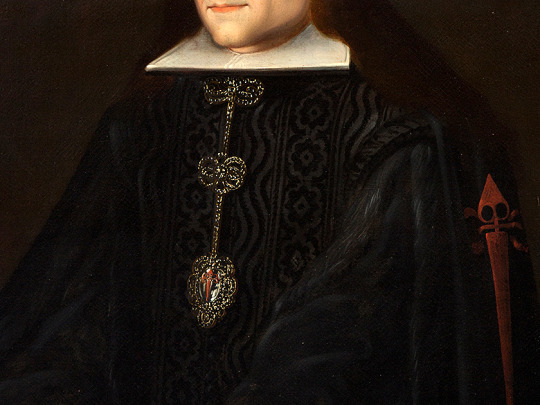
El Exmo. S. D. Joseph Sarmiento Valladares Conde de Moctesuma 31 Virrey y Cappn. Genl. (detail)
by unknown artist of the Novohispanic court
oil on canvas, c. 1697
Castillo de Chapultepec
#683863491714711552/Q3siH4vK#Anonymous#Fashion#House of Acamapichtli#Joseph Sarmiento de Valladares#Duque de Atrisco#Viceroy of New Spain#Monarquía Hispánica#Spanish Empire#Viceroyalty of New Spain#17th century#1697#Baroque#Museo Nacional de Historia#Order of Santiago#Spanish nobility#Novohispanic nobility#portraits#oil on canvas#paintings
14 notes
·
View notes
Text
One thing that bugs me in EU4 is that colonial regions are large and not very dynamic. The political arrangements governing colonial holdings in the New World changed dramatically in the period the game covers, and apparently large political formations like the Spanish viceroyalties of New Spain or the Río de la Plata covered very sprawling, loosely-associated smaller polities (in the Spanish case, a lot of smaller audiencias), some of which became independent states in their own right after overseas rule ended, and some of which fragmented even further. Some regional associations lasted just long enough to fight wars of independence--the comparable case here is if after the Revolutionary War, the Continental Congress had dissolved and every state gone its own way, which was not an implausible outcome!--and of course some survived.
Colonization itself involved a mix of state endeavours, private endeavors, and opportunism by rogue agents of European states (Cortez is a good example here), and there were competing claims to territory between European states that didn’t really map to direct political control but which were nevertheless important parts of colonial competition and negotiation.
You could model a little of this just by having colonial nations be smaller, but there’s no way to change colonial regions in-game, or to create colonial nations by event, which really limits the possibilities for modding some of these dynamics in. Ideally, i’d like a version of the tribal land system for European powers, reflecting the fur trapping and trading that preceded more intense colonial settlement in most of the North American interior, and which could reflect European claims to land that they didn’t directly control. I’d like events or decisions to merge smaller colonial nations/regions into larger ones as they become larger and more developed, and for smaller colonial nations to band together to overthrow their overlord, and/or for combined colonial states to dissolve into infighting (a la the UPCA, or Gran Columbia, or the independent states that emerged out of the viceroyalty of the Río de la Plata). Ways of colonizing upriver, too, like establishing fur trading forts in the interior of North America without having to have a densely settled strip from New Orleans or Montreal all the way to the deep interior.
#and more alliances between colonial and native nations#and reasons for european powers to ally natives#or a way to ask for their help in colonial wars#it's such a dynamic period of history!#and eu4 doesn't do it justice at all#eu4
19 notes
·
View notes
Photo
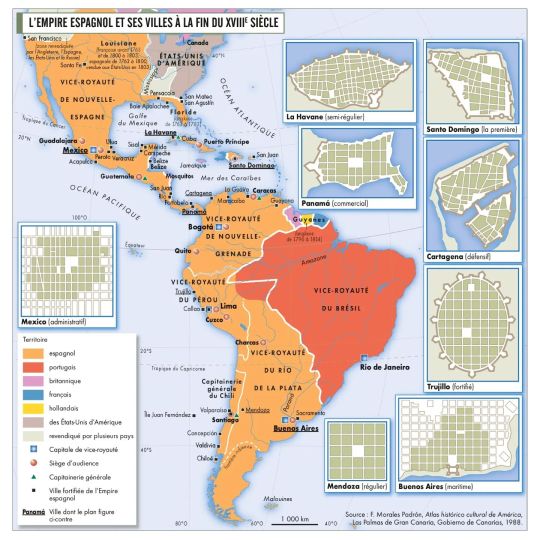
Spanish America
"Atlas des premières colonisations", Autrement, 2013
by cartesdhistoire
74 notes
·
View notes
Note
Mexico x Philippines?
A+: OTP
A: I love it
B: It’s really cute
Definitely love the idea of it! Even if they weren't romantic I can see them getting along, sharing chismis and catching up with one another over merienda. Their history is a shared one, albeit unfortunately through Spanish conquest over them and forged initially through galleon trade, but that shared history was mutually formative at the same time. They like to bond over shared aspects of their culture, their shared love of music and food, and sometimes indulge in waxing romanticisms over shared visits they had between Manila to Acapulco once upon a time. Less remembered and somewhat more contentious for better and for worse is how as New Spain, Elena was technically the one with more influence and authority over Amihan, as the Philippines was just a territory within New Spain while Mexico was the viceroyalty’s heart (both colonies for sure, but not on the same ground).
Overall though? They might not think about each other that much on most days, but when they do meet and catch up, it's a familiarity and closeness that hasn't worn out with time.
Send me a ship and I will grade it!
#fandom: hetalia#mexphil#also I see Mexico as female so like#with my PH OC#one of the wlw ships we all need#my hc name for Mexico is Elena Azuela Vicario#so there you go!!#hws philippines#hws mexico
8 notes
·
View notes
Text

The May Revolution, by Francisco Fortuny, 1910.
The news of the dissolution of the Junta Central, the provisional government of Spain, arrived in Buenos Aires on May 14 of 1810. On the 18, the Viceroy, Baltasar Hidalgo de Cisneros, issued a public proclamation announcing the critical state of Spain. This ignited political talks and the porteños started to demand for the Viceroy to call for an Open Cabildo to deliberate the future of the government, which he eventually did on the 22. After after days of agitated debate, and pressed by armed groups that had gathered around the Cabildo, on May 25 Viceroy Cisneros was removed from his charge and a Junta made up by the members of the Cabildo was formed to assume the government of the Viceroyalty of the Río de La Plata. Known today as the "Primera Junta", it's considered the first patriotic government of current-day Argentina. Although formed in the name of King Fernando VII, many of its members already considered Spain lost to the French and had in mind the independence of the territory, which was only declared on July 9 of 1816.
#there aren't contemporary images of the cabildo in 1810 - most images of it were made for the centenary#but it was raining that day!#may revolution#artist: francisco fortuny
5 notes
·
View notes